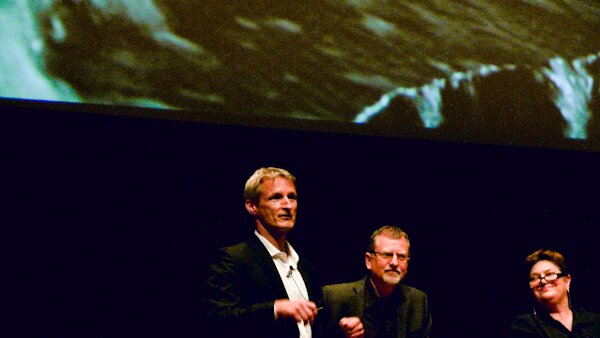 For WRT, Atelier Dreiseitl's "German guy" talks about what you can do with water. (A lot.)
For WRT, Atelier Dreiseitl's "German guy" talks about what you can do with water. (A lot.)
The orchestra level of Benaroya Hall was more or less full last night, maybe 1,200 people, for a Seattle Central Waterfront Project design presentation that was in fact a public candidate interview session. What would you do with 20 acres of "new" public space, around nine of which is actual waterfront? (In his introduction, the DPD's Planning Director Marshall Foster led the audience in a raucous cheer for the Viaduct finally coming down.)
A little while ago, the city of Seattle shortlisted four candidate firms for lead waterfront designer, and this event was supposed to find out how they "clicked" with Seattle (Seattle in this case being largely "people who live downtown" and "people who work for local architectural firms").
Since the design process is supposed to start this October, the finalist should be chosen fairly soon, probably next week. To judge from Twitter, locals GGN either packed the audience with partisans or really smacked it out of the park. (Look, you have your heuristics, I have mine.) Review the presenters' PowerPoint decks at your leisure.
For a concise summary of the evening's presentations, I direct you to the Stroupe Group (or, if you have a subscription, to the Daily Journal of Commerce) while I walk "around" the event and look for salient moments. [UPDATE: Katie from the DJC popped by the comments with links to open-to-the-public stories: This is local commentary on the team presentations. This is coverage from the night of. This is a special section overview of each team.]
First, there was some irony in the Department of Planning and Development organizing the evening; I would swear that as of the day before, when I visited their site to confirm the time, I was still being told to show up at 6 p.m., but last night a piece of paper taped to the doors alerted me and about 50 others that the new time was 7 p.m. Seems like a misstep, doesn't it, for a planning agency to need to make a last-minute change?
As it turned out, the lobby opened at 6:20, and they started letting people into the auditorium around 6:40 p.m. Normally I wouldn't have been so time-conscious, but with a 6 p.m. start, I hadn't had time to make dinner before rushing off downtown. No matter, I mean, I was standing in an arcade catering to people waiting for events to start after all.
The Third Avenue arcade in Benaroya closes up sometime before 6 p.m.
For the rest of the evening, when presenters mentioned "activating public spaces," I had the above, bizarre picture in mind. Benaroya Hall, open since 1998, the jewel of the city, can't keep three or four little shopfronts open past 5:30 p.m. on a weeknight. Outside, Third Avenue was all hustle and bustle. Inside, not.
Well, nothing to see (or eat) here.
The two presentations I stayed for, from Wallace Roberts Todd and James Corner's Field Operations, were so buzzword heavy I wanted to shoot myself. They both featured lots of dramatic photography, and delivered a strong sense that the participants would really be geared up to do something awesome as soon as the first check clears. In the meantime, here are some more pictures of smiling people in architectural settings while we drone on about "multisensory experiences," "connective pathways," and the "working waterfont."
WRT did provide what I think should be the motto of the project: "If it's rainy, that should be a reason to go to the waterfront." Less successful were "making the seam the heart of Seattle," and dragooning into service what they told us was the Native American expression, "When the tide is out, the table is set." Show me your Native American architect, and we'll talk about what phrases you can use.
James Corner, illustrating the impact of dramatic lighting
James Corner, whose presentation I liked, all things being equal, nattered on about wanting to keep our authentic grittiness. Like Manchester, where he's from. As it happened, while the four teams (the other two being Gustafson Guthrie Nichol and Michael Van Valkenburgh Associates) were being grilled by questions passed up from the multitudes in designer shoes, glasses, and haircuts, three people were being stabbed near Victor Steinbrueck Park. Too gritty?
Field Operations' pet phrase was "Seattle's front porch." (Ugh.) But they also mentioned "cities reaching down to touch the water," which is an evocative image, so good on them. They are the people who turned New York's High Line into a public attraction, so if you are determined to keep something of the Viaduct around, they're your lead choice.
The moderator, Daniel Friedman, dean of the UW's Built Environments program, made a point of asking Corner about how his "dramatic," "theatrical" design would incorporate the history of local Native Americans, "who are always in our thoughts" (or words to that effect). Corner squirmed, and I did, too, possibly for different reasons. I can only tell you what I thought, which is that Seattle is not going to design its way out of shooting wood carvers in the street.
This city has a disturbing fetish for appropriating native culture in design. I suppose it's well-intentioned, but it almost without fail turns to a semi-mythic past, rather than engaging with the present-day reality. My feeling is, if you want to honor local tribes, give them back part of that 20 acres and let them come up with something. But I am dangerously near a digressive rant, and you have better things to do. I suggest you get to them, and tune back in when our finalist is announced.
 Subscribe to our Front Page Stories
Subscribe to our Front Page Stories
![]() Subscribe to all SunBreak Stories
Subscribe to all SunBreak Stories



Most Recent Comments